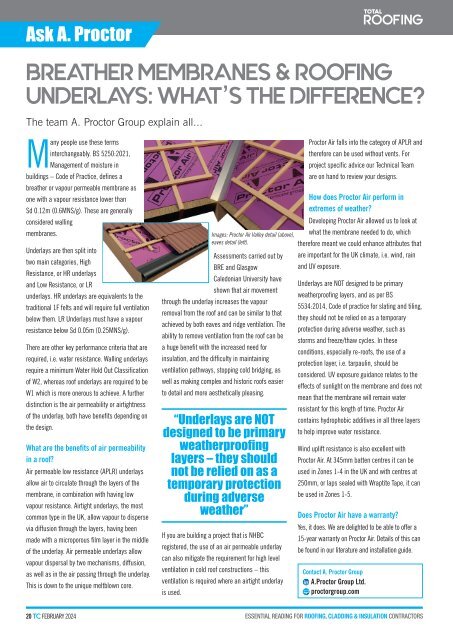February 2024
You also want an ePaper? Increase the reach of your titles
YUMPU automatically turns print PDFs into web optimized ePapers that Google loves.
Ask A. Proctor<br />
BREATHER MEMBRANES & ROOFING<br />
UNDERLAYS: WHAT’S THE DIFFERENCE?<br />
The team A. Proctor Group explain all...<br />
Many people use these terms<br />
interchangeably. BS 5250:2021,<br />
Management of moisture in<br />
buildings – Code of Practice, defines a<br />
breather or vapour permeable membrane as<br />
one with a vapour resistance lower than<br />
Sd 0.12m (0.6MNS/g). These are generally<br />
considered walling<br />
membranes.<br />
Underlays are then split into<br />
two main categories, High<br />
Resistance, or HR underlays<br />
and Low Resistance, or LR<br />
underlays. HR underlays are equivalents to the<br />
traditional 1F felts and will require full ventilation<br />
below them. LR Underlays must have a vapour<br />
resistance below Sd 0.05m (0.25MNS/g).<br />
There are other key performance criteria that are<br />
required, i.e. water resistance. Walling underlays<br />
require a minimum Water Hold Out Classification<br />
of W2, whereas roof underlays are required to be<br />
W1 which is more onerous to achieve. A further<br />
distinction is the air permeability or airtightness<br />
of the underlay, both have benefits depending on<br />
the design.<br />
What are the benefits of air permeability<br />
in a roof?<br />
Air permeable low resistance (APLR) underlays<br />
allow air to circulate through the layers of the<br />
membrane, in combination with having low<br />
vapour resistance. Airtight underlays, the most<br />
common type in the UK, allow vapour to disperse<br />
via diffusion through the layers, having been<br />
made with a microporous film layer in the middle<br />
of the underlay. Air permeable underlays allow<br />
vapour dispersal by two mechanisms, diffusion,<br />
as well as in the air passing through the underlay.<br />
This is down to the unique meltblown core.<br />
Images: Proctor Air Valley detail (above),<br />
eaves detail (left).<br />
Assessments carried out by<br />
BRE and Glasgow<br />
Caledonian University have<br />
shown that air movement<br />
through the underlay increases the vapour<br />
removal from the roof and can be similar to that<br />
achieved by both eaves and ridge ventilation. The<br />
ability to remove ventilation from the roof can be<br />
a huge benefit with the increased need for<br />
insulation, and the difficulty in maintaining<br />
ventilation pathways, stopping cold bridging, as<br />
well as making complex and historic roofs easier<br />
to detail and more aesthetically pleasing.<br />
“Underlays are NOT<br />
designed to be primary<br />
weatherproofing<br />
layers – they should<br />
not be relied on as a<br />
temporary protection<br />
during adverse<br />
weather”<br />
If you are building a project that is NHBC<br />
registered, the use of an air permeable underlay<br />
can also mitigate the requirement for high level<br />
ventilation in cold roof constructions – this<br />
ventilation is required where an airtight underlay<br />
is used.<br />
Proctor Air falls into the category of APLR and<br />
therefore can be used without vents. For<br />
project specific advice our Technical Team<br />
are on hand to review your designs.<br />
How does Proctor Air perform in<br />
extremes of weather?<br />
Developing Proctor Air allowed us to look at<br />
what the membrane needed to do, which<br />
therefore meant we could enhance attributes that<br />
are important for the UK climate, i.e. wind, rain<br />
and UV exposure.<br />
Underlays are NOT designed to be primary<br />
weatherproofing layers, and as per BS<br />
5534:2014, Code of practice for slating and tiling,<br />
they should not be relied on as a temporary<br />
protection during adverse weather, such as<br />
storms and freeze/thaw cycles. In these<br />
conditions, especially re-roofs, the use of a<br />
protection layer, i.e. tarpaulin, should be<br />
considered. UV exposure guidance relates to the<br />
effects of sunlight on the membrane and does not<br />
mean that the membrane will remain water<br />
resistant for this length of time. Proctor Air<br />
contains hydrophobic additives in all three layers<br />
to help improve water resistance.<br />
Wind uplift resistance is also excellent with<br />
Proctor Air. At 345mm batten centres it can be<br />
used in Zones 1-4 in the UK and with centres at<br />
250mm, or laps sealed with Wraptite Tape, it can<br />
be used in Zones 1-5.<br />
Does Proctor Air have a warranty?<br />
Yes, it does. We are delighted to be able to offer a<br />
15-year warranty on Proctor Air. Details of this can<br />
be found in our literature and installation guide.<br />
Contact A. Proctor Group<br />
A.Proctor Group Ltd.<br />
proctorgroup.com<br />
20 TC FEBRUARY <strong>2024</strong>
















